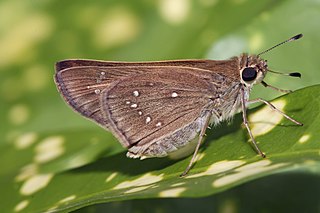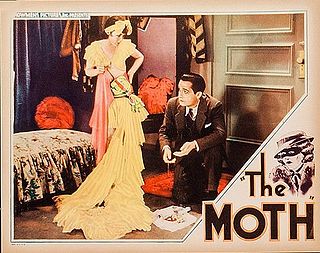
Caterpillars are the larval stage of members of the order Lepidoptera.

Butterflies are insects that have large, often brightly coloured wings, and a conspicuous, fluttering flight. The group comprises the superfamilies Hedyloidea and Papilionoidea. Butterfly fossils date to the Paleocene, about 56 million years ago.

Lepidoptera is an order of insects that includes butterflies and moths. About 180,000 species of the Lepidoptera are described, in 126 families and 46 superfamilies, 10 percent of the total described species of living organisms. It is one of the most widespread and widely recognizable insect orders in the world. The Lepidoptera show many variations of the basic body structure that have evolved to gain advantages in lifestyle and distribution. Recent estimates suggest the order may have more species than earlier thought, and is among the four most speciose orders, along with the Hymenoptera, Diptera, and Coleoptera.

Moths are a group of insects that includes all members of the order Lepidoptera that are not butterflies. They were previously classified as suborder Heterocera, but the group is paraphyletic with respect to butterflies and neither subrdinate taxa are used modern classifications. Moths making up the vast majority of the order. There are thought to be approximately 160,000 species of moth, many of which have yet to be described. Most species of moth are nocturnal, but there are also crepuscular and diurnal species.

The domestic silk moth is an insect from the moth family Bombycidae. It is the closest relative of Bombyx mandarina, the wild silk moth. The silkworm is the larva or caterpillar of a silk moth. It is an economically important insect, being a primary producer of silk. A silkworm's preferred food are white mulberry leaves, though they may eat other mulberry species and even the osage orange. Domestic silk moths are entirely dependent on humans for reproduction, as a result of millennia of selective breeding. Wild silk moths are not as commercially viable in the production of silk.

Nicotiana is a genus of herbaceous plants and shrubs in the family Solanaceae, that is indigenous to the Americas, Australia, Southwestern Africa and the South Pacific. Various Nicotiana species, commonly referred to as tobacco plants, are cultivated as ornamental garden plants. N. tabacum is grown worldwide for the cultivation of tobacco leaves used for manufacturing and producing tobacco products, including cigars, cigarillos, cigarettes, chewing tobacco, dipping tobacco, snuff, and snus.

The de Havilland Aircraft Company Limited was a British aviation manufacturer established in late 1920 by Geoffrey de Havilland at Stag Lane Aerodrome Edgware on the outskirts of north London. Operations were later moved to Hatfield in Hertfordshire.

The Sphingidae are a family of moths (Lepidoptera) called sphinx moths, also colloquially known as hawk moths, with many of their caterpillars known as “hornworms”; it includes about 1,450 species. It is best represented in the tropics, but species are found in every region. They are moderate to large in size and are distinguished among moths for their agile and sustained flying ability, similar enough to that of hummingbirds as to be reliably mistaken for them. Their narrow wings and streamlined abdomens are adaptations for rapid flight. The family was named by French zoologist Pierre André Latreille in 1802.

Skippers are a family of the Lepidoptera named the Hesperiidae. Being diurnal, they are generally called butterflies. They were previously placed in a separate superfamily, Hesperioidea; however, the most recent taxonomy places the family in the superfamily Papilionoidea, the butterflies. They are named for their quick, darting flight habits. Most have their antenna tips modified into narrow, hook-like projections. Moreover, skippers mostly have an absence of wing-coupling structure available in most moths. More than 3500 species of skippers are recognized, and they occur worldwide, but with the greatest diversity in the Neotropical regions of Central and South America.

Bookworm is a general name for any insect that is said to bore through books.

The superfamily Papilionoidea contains all the butterflies except for the moth-like Hedyloidea.

The Pyralidae, commonly called pyralid moths, snout moths or grass moths, are a family of Lepidoptera in the ditrysian superfamily Pyraloidea. In many classifications, the grass moths (Crambidae) are included in the Pyralidae as a subfamily, making the combined group one of the largest families in the Lepidoptera. The latest review by Eugene G. Munroe and Maria Alma Solis retain the Crambidae as a full family of Pyraloidea.

Killer Moth is a supervillain appearing in comic books published by DC Comics, usually as an adversary and dedicated original foil personality of Batman. Like Batman, he has no superpowers and relies on his technical equipment, including a Mothmobile and numerous gimmicks. Killer Moth originally wore a garish costume of purple and green striped fabric, with an orange cape and moth-like mask. In Underworld Unleashed, Killer Moth is transformed into the monster Charaxes with superhuman abilities.

Gelechioidea is the superfamily of moths that contains the case-bearers, twirler moths, and relatives, also simply called curved-horn moths or gelechioid moths. It is a large and poorly understood '"micromoth" superfamily, constituting one of the basal lineages of the Ditrysia.

In ecology, crypsis is the ability of an animal or a plant to avoid observation or detection by other animals. It may be a predation strategy or an antipredator adaptation. Methods include camouflage, nocturnality, subterranean lifestyle and mimicry. Crypsis can involve visual, olfactory or auditory concealment. When it is visual, the term cryptic coloration, effectively a synonym for animal camouflage, is sometimes used, but many different methods of camouflage are employed by animals or plants.

The Moth is a small development class of sailing dinghy. Originally a small, fast home-built sailing boat designed to plane, since 2000 it has become an expensive and largely commercially-produced boat designed to hydroplane on foils though many are still built at home, typically at much lower cost.

The Moth is a non-profit group based in New York City dedicated to the art and craft of storytelling. Founded in 1997, the organization presents a wide range of theme-based storytelling events across the United States and abroad, often featuring prominent literary and cultural personalities alongside everyday people like veterans, astronauts, school teachers, and parents. The Moth offers a weekly podcast and in 2009 launched a national public radio show, The Moth Radio Hour, which won a 2010 Peabody Award. The Moth has published four books including The Moth: 50 True Stories (2013) reached #22 on The New York Times Paperback Nonfiction Best-Seller List; All These Wonders: True Stories about Facing the Unknown (2017); and Occasional Magic: True Stories About Defying the Impossible (2019) and How to Tell a Story: The Essential Guide to Memorable Storytelling from The Moth (2022). In September of 2022, The Moth published an interactive card deck called, A Game of Storytelling, which debut at #1 on Amazon's top selling card game list.

Scythrididae is a family of small moths in the superfamily Gelechioidea. The family is sometimes included in the Xyloryctidae as a subfamily Scythridinae, but the Xyloryctidae themselves have sometimes been included in the Oecophoridae as subfamily. Scythrididae adults are smallish to mid-sized moths, which when at rest appear teardrop-shaped.

The Moth is a 1934 American crime drama film directed by Fred C. Newmeyer about an irresponsible, disinherited heiress called Diane who heads for New Orleans and crosses paths with a jewel thief who is a notorious criminal known as The Moth.

Perivale Wood is an 11.6 hectare Local Nature Reserve (LNR) and Site of Metropolitan Importance for Nature Conservation in Perivale in the London Borough of Ealing. It is one of the oldest nature reserves in Britain. The Selborne Society has managed it since 1902, at first as a bird sanctuary. In 1914 it leased the site and in 1923 it purchased it. The wood was designated an LNR in 1974.



















